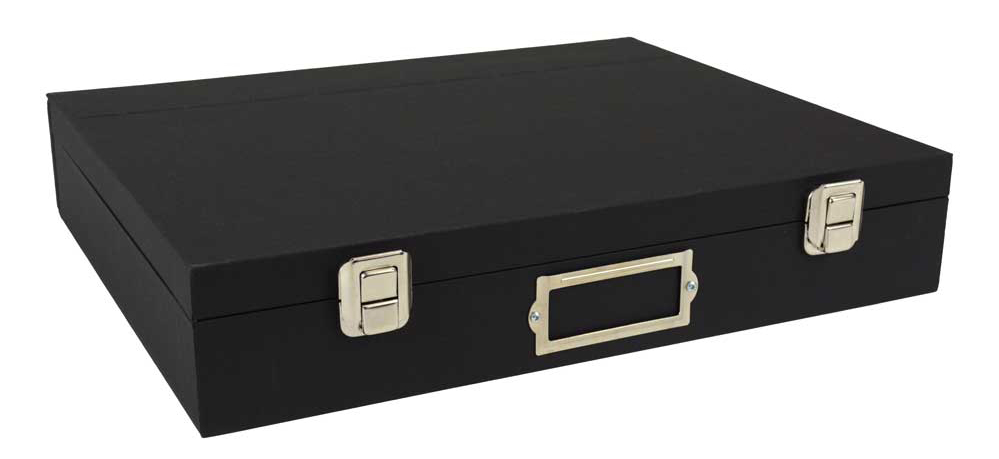(in honor of Daniel Solander’s birthday!)
Under the Portfolios & Cases category on the Archival Methods website you will find our higher end boxes and travel cases. Metal Edge Boxes are the more affordable workhorses, and the backbone of institutional and home archives. Portfolios and Cases are used for archival storage but they are also provide sturdy transport and professional looking presentation of artwork.

Why Invest in a Museum Solander Case
Our Museum Solander Case is a Solander box, which is a clamshell style box that opens to lie flat. The Solander is a basswood-sided box with hinged top and a recessed lip to protect against dust, insects, and airborne contaminants. Basswood has a low resin content and good structural characteristics. The exterior of the box is covered in black archival book cloth and the interior is lined with 100% cotton 4-Ply Museum Board.
The rigid wood sides allow for the use of metal latches to secure the lid in place, which helps when moving the box. The wood structure resists twisting or flexing when carrying large boxes, and makes them sturdy for stacking. The box is also equipped with a metal label holder.
Speaking of high level protection, I came across this blog post that illustrated the effectiveness of Solander cases to protect rare books from water damage.

Development of the First Solander Box
Daniel Solander (19 February 1733 – 13 May 1782) is credited with creating this style of box which he used to protect books, manuscripts, drawings, and dried plant specimens. He studied natural history with Carl Linnaeus at Uppsala University and then immigrated to England and worked at the British Museum cataloging the natural history collection.

In 1768 Solander and fellow botanist, Joseph Banks, set sail as part of James Cook’s first expedition to the Pacific Ocean on the Endeavor. The ship was damaged and beached on the coast of Australia for many weeks, during which time they collected a large variety of plant specimens.

Classic Box Now Made with Archival Materials
Even though Daniel Solander didn’t have acid-free archival board and paper for constructing his storage boxes, the basic design and structure was so good that it is still being used over 250 years later!

All of our portfolios, boxes, and binders are handmade in Rochester, NY. Museum Solander Cases are the most time-consuming product that we make. If you order one or more and there are not enough on the shelf to fulfill your order, it may take 3 – 4 weeks from the time of ordering for us to ship it. On the website, if you see a note that says In Production next to the size box you want, place your order to be sure it is added to our production schedule.
Museum Solander Box Sizes
Off-the-shelf sizes accommodate prints or mats from 11 x 14″ up to 30 x 40″. The dimensions listed reflect the interior measurements. To determine the outside dimensions of a case add: 7/8’’ to length, 1-1/8’’ to width (includes latches), 1/2’’ to height.
If you would like a custom size Museum Solander Case there is a five box minimum. We only offer them in a 2-1/2″ depth and the largest box we can make is 33-1/2 x 44-1/2 x 2-1/2″. We are able to offer the Arlington book cloth in other colors if you don’t want black.
Archival Specs
On our website most products have an info tab called Specifications. Here are the specs for Archival Methods’ Museum Solander Cases.
• PAT tested and passed
• Case top and bottom is Kappa binder’s board (.142), a bookmaking board with no glue between layers
• Interior bottom tray is made of 100% 4 Ply Cotton Mat Board, Adhesive: modified starch, min. pH 8.5. top is lined with 15 pt. white acid- and lignin-free card stock
• Covered in book binding cloth with a moisture-resistant, 100% aqueous acrylic coating
• Adhesive is EVA, pH balanced and buffered, <.0008% sulfur content
• Reinforced hinge, with dust flap
• Sides and spine are made of low-resin basswood
• Close-tolerance construction to keep out dust
Questions?
If you have questions about our Museum Solander Case or other archival concerns, please contact us and we’ll do our best to answer them!
